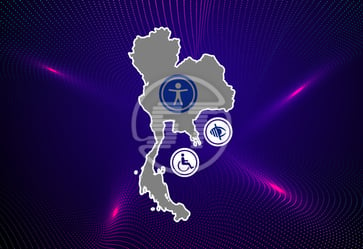Digital accessibility extends beyond physical spaces to online environments. For public entities, this means ensuring that digital platforms—websites, mobile applications, and other online services—are accessible to everyone, including individuals with disabilities. The recent update to Title II of the Americans with Disabilities Act (ADA) has significantly reshaped how public entities must approach digital accessibility.
This article explores the implications of the update and how public entities can comply to foster inclusivity.
Title II of the ADA and its update!
Title II of the ADA prohibits discrimination on the basis of disability by public entities, including state and local governments. The law mandates that individuals with disabilities have equal access to digital content including programs, services, and activities offered by these entities.
Initially, Title II focused primarily on physical accessibility. But as technology has evolved, the digital realm become an equally essential part of public access.
The U.S. Department of Justice (DOJ) recognized the increasing importance of digital accessibility and the lack of clarity around how Title II applies to digital services.
The updated guidelines get effective from June 24, 2024, and they aim to:
- Address ambiguities: Clarify the obligations of public entities to ensure digital accessibility.
- Reflect technological advancements: Account for the shift from physical to digital spaces in service delivery.
- Promote inclusive public services: Ensure individuals with disabilities have equal access to digital information and services.
New modifications in the ADA Title II
The updated Title II guidelines introduce several critical changes:
Expanded scope of digital accessibility
The update explicitly includes digital assets such as websites, mobile apps, digital kiosks, and online forms and documents. This expansion ensures that all digital services are held to the same global website accessibility standards as physical spaces.
Adoption of WCAG standards
Public entities are required to comply with the WCAG 2.1, a widely recognized standard to ensure web accessibility. Key requirements include:
- Content should be perceivable.
- It must be operable.
- Understandable for all users.
- And robust with a variety of assistive devices.
Accessibility testing and monitoring
Public entities must implement ongoing testing and monitoring of their digital assets to ensure uninterrupted compliance. This includes conducting:
- Automated accessibility audit
- Manual user accessibility testing by individuals with disabilities
- Regular updates and remediation of accessibility issues
Public feedback mechanisms
The update emphasizes the importance of user feedback. Public entities ought to provide accessible ways for individuals to report accessibility issues and must respond promptly to address them.
Training and Awareness
Team members responsible for maintaining digital platforms must undergo training on accessibility best practices to ensure compliance across all digital touchpoints.
Impact of the ADA updates on public entities
Increased responsibility
Public entities must now prioritize digital accessibility in their core processes. This may require profound investments in technology, training, and personnel to meet compliance standards.
Enhanced user experience
While the update imposes new requirements, it also offers an opportunity to fine-tune the overall user experience. Accessible digital platforms are often more user-friendly for everyone, not just individuals with disabilities.
Legal and financial implications
Non-compliance with the updated ADA Title II guidelines can result in legal action, fines, and reputational damage. Public entities must act proactively to potential lawsuits and ensure equal access for all citizens.
Steps to achieve compliance as per ADA guidelines
Public entities can take the following steps to comply with the updated ADA Title II guidelines:
Conduct an accessibility audit
Evaluate existing digital assets for compliance with WCAG 2.1 standards.
Develop an accessibility action plan
Create a roadmap for addressing identified accessibility gaps, including timelines and resource allocation.
Engage accessibility experts
Collaborate with web accessibility consultants specializing in digital accessibility to ensure best accessibility practices are followed.
Implement inclusive design principles
Incorporate accessibility into the design and development process of new digital assets from the outset.
Monitor and update regularly
Regularly review and update digital assets to maintain compliance as technology and standards evolve over time.
The cut-off date to comply with ADA Title II new updates!
The DOJ (Department of Justice) has given ample time to achieve compliance based on the size of the public entity.
Entities with a strength of 50,000 or more ought to be fully compliant by April 24, 2026. However, public entities with a strength of less than 50,000 have an extra year. They should be in compliance by April 26, 2027.
All state and local government organizations and agencies are expected to comply with ADA Title II including:
- Public schools: Pre-schools, elementary schools, and high schools
- Public libraries
- Community colleges and public universities
- State and local courts.
Exceptions that are applicable to some of the digital content!
There are content exceptions given by the DOJ for public websites and applications. Five categories of content that are not required to adhere to the new rule fact sheet:
- Pre-existing Conventional Electronic Documents: If the document was published before the new rule's effective date (June 24, 2024), it does not need to be retrofitted. This includes PDFs and other electronic documents.
- Archived web content: Historical documents and web pages are exempted because they were archived before the rule came into effect.
- Third-party content: User-generated content such as comments and posts are exempted, and websites are not required to amend them.
- Pre-existing social media posts: Social media posts (including Facebook and Twitter posts), published before the new updates effective date, are exempted.
- Individualized password-protected documents: Any document that is personalized and password-protected does not need to conform with ADA Title II new updates—for instance, secure online forms and reports made for some specific user.
In a nutshell,
The ADA Title II update underlines the critical role of digital accessibility in promoting inclusivity to public services. By embracing these changes, public entities can not only comply with the law but also encourage a more inclusive digital environment that benefits all users.
As technology continues to evolve, prioritizing accessibility will remain essential in creating equitable public spaces—both physical and digital!
The ADA Title II update underscores the importance of digital accessibility for public entities, emphasizing the need for compliance with accessibility standards. As public websites face increasing scrutiny, it's essential to take proactive steps to ensure full accessibility for all users. Our website accessibility remediation services offer a comprehensive solution to help public entities navigate the complexities of the update, ensuring compliance and improving user experience. By leveraging our expert website accessibility remediation services, public entities can minimize legal risks, enhance their digital presence, and demonstrate a commitment to inclusivity. Now is the time to act and ensure website meets the latest accessibility standards.


